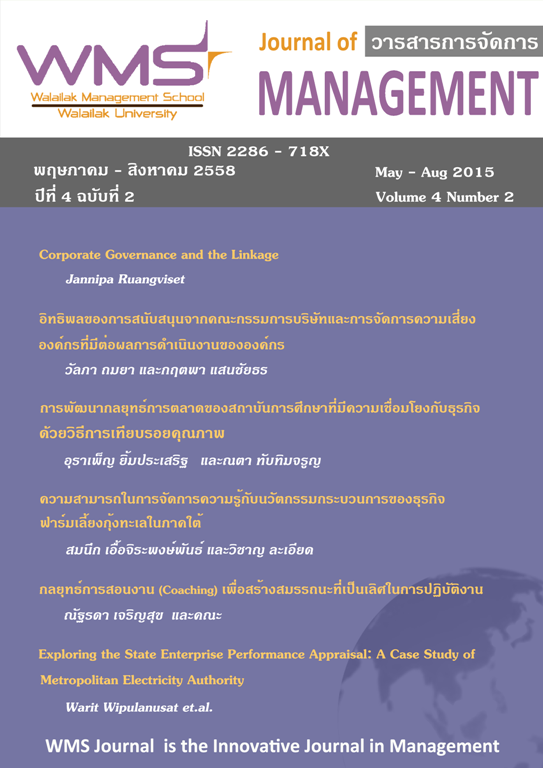The Development of Marketing Strategy of Corporate University through Benchmarking
Main Article Content
Abstract
Article Details
References
ณตา ทับทิมจรูญ, 2552. การพัฒนาส่วนประสมการตลาดด้วยวิธีการเทียบรอยคุณภาพของสถาบันเทคโนโลยีนานาชาติสิรินธรมหาวิทยาลัยธรรมศาสตร์. วิทยานิพนธ์ปรัชญาดุษฎีบัณฑิต สาขาการจัดการคุณภาพ มหาวิทยาลัยราชภัฏสวนสุนันทา.
บริษัท ซีพี ออลล์ จำกัด (มหาชน) .2554. รายงานผลการดำเนินงานปี 2554. กรุงเทพฯ: บริษัท ซีพี ออลล์ จำกัด (มหาชน).
วิจิตร ศรีสอ้าน. 2551. บทความทางวิชาการประกอบการเสวนาวิชาการ เนื่องในโอกาสวันสถาปนา มหาวิทยาลัยสุโขทัยธรรมาธิราช ครบรอบ 30 ปี. (น. 1-3). นนทบุรี: สำนักพิมพ์มหาวิทยาลัยสุโขทัยธรรมาธิราช.
สมภพ มานะรังสรรค์. 2554. การบริหารสถาบันการศึกษา ในศตวรรษที่ 21. ผู้จัดการ 360° รายสัปดาห์. แหล่งที่มา: http://www.manager. co.th/mgrWeekly/ViewNews.aspx.
สถาบันการจัดการปัญญาภิวัฒน์. 2554. คู่มือนักศึกษา. กรุงเทพฯ: สถาบันการจัดการปัญญาภิวัฒน์.
สุพัตรา คูหากาญจน์. 2542. การพัฒนาการจัดการเรียนการสอนระดับบัณฑิตศึกษา ภาควิชาโสตทัศนศึกษา จุฬาลงกรณ์มหาวิทยาลัยโดยวิธีเบนชมาร์กกิงกับแผนกวิชาวิทยาศาสตร์การสอนสถาบันการศึกษาแห่งชาติมหาวิทยาลัยนานยาง. วิทยานิพนธ์ปรัชญาดุษฎีบัณฑิต จุฬาลงกรณ์มหาวิทยาลัย.
อดุลย์ จาตุรงคกุล. 2549. กลยุทธ์การตลาด. กรุงเทพฯ: โรงพิมพ์มหาวิทยาลัยธรรมศาสตร์.
อุทุมพร จามรมาน. 2544. การวิจัยและพัฒนาดัชนี เกณฑ์และวิธีประเมินคุณภาพการศึกษาภายในและภายนอก
สำหรับสถาบันอุดมศึกษาไทย. กรุงเทพฯ: สำนักงานการอุดมศึกษาแห่งชาติ.
Bischoff. 2004. Nonprofit marketing with a purpose: Developing a strategic marketing plan to engage new audiences. Retrieved March 29, 2006, from ABI database.9 (5), 429-449.
Creswell, J.W., & Plano Clark, V. 2007. Designing and conducting mixed methods research. Thousand Oaks, CA: Sage.
Darrell & Barbara. 2011. Bain Management tool and trend. Retrieved May 11, 2011. from http://www.bain.com/ publications/articles/management-tools-trends-2011.pdf.
Lattanand. 2005. Formulating strategies for improving the educational management of nursing colleges under the jurisdiction of the Ministry of Public Health : benchmarking approach/konkanok lattanand Bangkok: Maidol University.
Motekaitiene & Juscius. 2008. Specifics of Marketing in Higher Education. Social Research. Nr. 2 (12), 97–103.
Soedijati & Pratminingsih. 2011. Marketing within higher education institutions - A case study of two private Thai universities. Mälardalen.
University, Västerås, Sweden. Retrieved May 11, 2011. from http://www.diva-portal.org/smash/get/diva2portal.org/smash/get/diva2:625908/FULLTEXT02.

